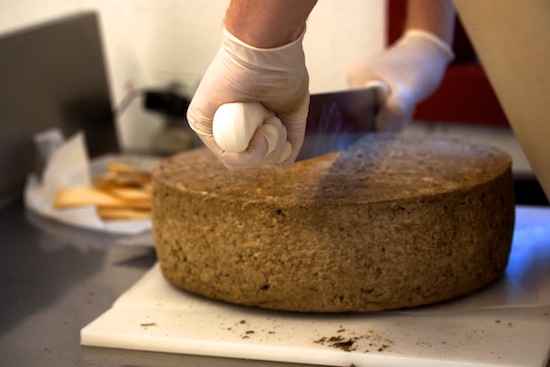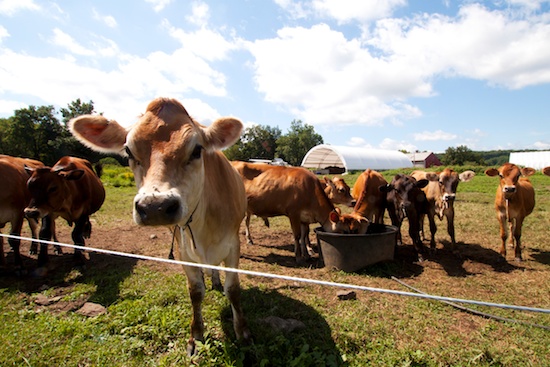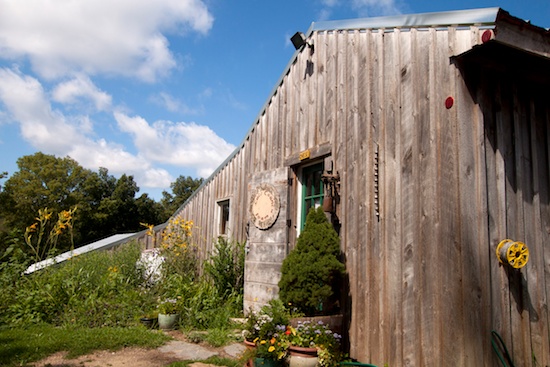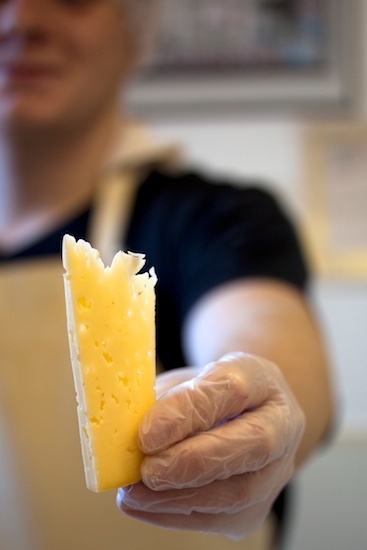For the Love of Cheese Part 2: Cato Corner Farm

Cato Corner Farm in Colchester, Connecticut produces a dozen styles of hand-made farmhouse cheeses from milk produced by their pasture-fed, hormone- and antibiotic-free Jersey cows. Elizabeth MacAlister, owner of the farm since 1979, began making cheeses in 1997. Her son Mark Gilman joined the operation in 1999 and is the head cheese maker.
They make cheeses four days a week at Cato Corner; Dianna Sadowski works as a cheese maker one of those days. She wears a white hair bonnet, long white lab jacket and knee-high shiny white rubber boots when she works, an outfit that underscores her role as scientist in the cheese making process. While touring the operation’s underground cheese cave–which was pungently acrid from thousands of wheels of cheese ripening–she described that cheese makers must understand microbiology, pH values, bacteria and ammoniating. “But, you have to use your senses, too,” she said. “You can smell when a culture changes. That’s an art.”

Dianna emphasized that in artisanal cheese making, the quality of the milk is important. At Cato Corner, their cows consume different grasses throughout the year, which in turn affects their milk and final cheeses. In the summer, for example, after the cows consume pasture grass for a few days, their milk becomes rich with antioxidants from the Beta Carotene pigment found in the grass, and their milk becomes tinted a noticeable yellow. Eventually, the eater of these cheeses benefits from the antioxidants. “At the end of the day, I’m proud I’ve made a tangible product that is healthy. It is satisfying that I am feeding my neighbors good, healthy products,” she said.

Cato Corner ages its various cheeses in their underground cave from two to twelve months. Dianna held up a wheel of Bridgid’s Abbey, a Trappist-style cheese with a creamy consistency. Before being set down to age, the wheels of Bridgid’s Abbey are brined and rubbed with salt to provide an environment that encourages mold growth; mold helps cheeses ripen. She held up a wheel of Black Ledge Blue to show how holes are punctured throughout to allow oxygen to enter the cheese, which creates bacterium and the cheese’s characteristic blue veins.

After emerging from the cool, humid cave, Mark Gilman assumed the role of tour guide; his animated six-year old daughter Charlotte assisted and was proud to show off the farm’s three-week old brown Jersey calves. Mark explained that they practice rotational grazing on the farm’s 75-acres to sustain the pastures’ plant life. Their forty cows produce 1,500 pounds of milk daily, which yields about 160 pounds of cheese. In addition to its sustainable agricultural practices, Cato Corner Farm contributes further to Connecticut’s quality of life–the Connecticut Farmland Trust holds the farm’s agricultural conservation easement, which will protect its pastures and agricultural infrastructure as productive farmland that can never be split up.

The tour was coming to an end, so their cheeses deserve more mention. While science is integral to cheese making, Elizabeth’s and Mark’s playful artistry is displayed when it comes to naming their products.
Cato Corner Farm is most proud of their Dairyere, which has a sharp, nutty flavor and recently won third place at the prestigious 2011 American Cheese Society Awards for the second consecutive year.
Bloomsday is one of their most popular cheeses and is aged for six months. Bloomsday was the fortunate result of a mistake made on June 16 so was named for the protagonist of James Joyce’s Ulysses. It has a drier texture and nutty flavor and is recommended for cheese platters or in grilled cheese sandwiches. Aged Bloomsday has a sharper, more intense flavor that is balanced by a touch of sweetness.

Mark explained that Hooligan is a stinky cheese that demanded a name to reflect its bold attitude. Hooligan was honored as an Outstanding Dairy Product by the Gallo Family Vineyards Gold Medal Awards in 2006. This ripe washed-rind cheese is bathed in brine twice each week to encourage surface-ripening bacteria that produce a creamy interior, orange rind and soft texture that melts well.
“Vivace needed an Italian name for its peppery bite,” said Mark. It is aged four to seven months and has a chewy, smooth texture and zippy finish.
 Womanchego was inspired by the Spanish sheep’s milk cheese Manchego. It is aged three to four months and has a mild taste with hints of fruit and nuts.
Womanchego was inspired by the Spanish sheep’s milk cheese Manchego. It is aged three to four months and has a mild taste with hints of fruit and nuts.
Despearado is washed with pear mash and locally produced Pear Willian eau de vie while ripening to produce a stronger version of Hooligan.
Additional cheeses include Bridgid’s Abbey, Drunk Monk, Fromage d’O’ Cow, Rapplaree, Dutch Farmstead, 6-Month Old Dutch Farmstead, Block’s Landing, Vivace Bambino, Molto Vivace, Black Ledge Blue, Cato Ransom Blue, Misty Morning, Jeremy River Cheddar and Myfanwy, which is based on a Welsh recipe that dates to the 1830s.
Cheese lovers have numerous options to support Cato Corner Farm’s sustainable agricultural practices and to purchase their cheeses. The farm store at 178 Cato Corner Road in Colchester is open Saturdays from 10 a.m. – 3 p.m. and Sundays from 11 a.m. – 3 p.m. In Fairfield County, their cheeses are sold at the Westport Farmer’s Market, Darien Cheese, Fairfield Cheese Company, Wilton’s Village Market and New Canaan’s Walter Stewart’s Market. For more information, visit www.catocornerfarm.com or find them on Facebook.
[Photography courtesy of Christina Venturini / Blue Pear Photography]
























